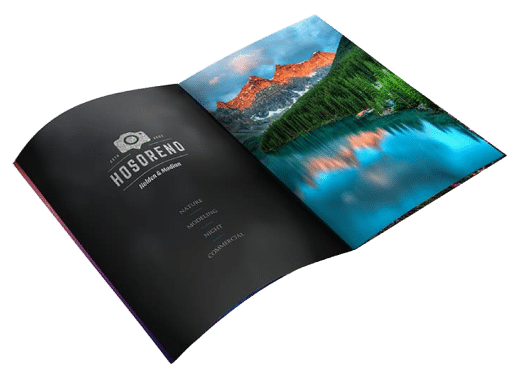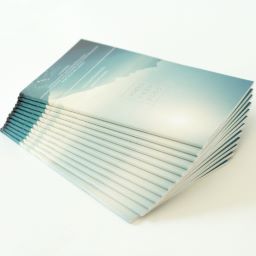Exploring Creative Layouts in Professional Booklet Printing
Exploring Creative Layouts in Professional Booklet Printing
Blog Article
The Crucial Overview to Comprehending Pamphlet Printing Options and Techniques
The process of pamphlet printing includes numerous considerations that can substantially impact the end product. From picking the proper format and size to recognizing the nuances of binding techniques, each choice plays a crucial function. In addition, aspects such as paper supply and printing techniques further influence the effectiveness of the booklet. As one browses these alternatives, it comes to be crucial to realize exactly how they interconnect and what that implies for the total end result.
Recognizing Pamphlet Dimensions and layouts
When taking into consideration brochure printing, recognizing the various layouts and dimensions readily available is crucial for attaining the wanted discussion. Pamphlets can be produced in various formats, including saddle-stitched, spiral-bound, and perfect-bound, each offering distinct benefits. Usual dimensions range from basic letter (8.5 x 11 inches) to smaller sized options like A5 (5.8 x 8.3 inches), enabling for flexibility based on material and target audience.Selecting the ideal dimension can affect both the layout and visitor involvement. Bigger dimensions could fit visually driven material, while smaller layouts may be a lot more portable and easy to use. Furthermore, the number of pages influences the choice of binding method, as thicker booklets may need stronger bindings. Ultimately, understanding these elements enables a more tailored method, making certain that the end product lines up with the intended message and aesthetic, enhancing the total performance of the interaction.
Picking the Right Paper Supply
Binding Methods: Factors To Consider and options
When it involves binding approaches for pamphlets, a number of options are offered, each with distinct benefits. Saddle stitch binding provides a cost-effective remedy for thinner brochures, while excellent binding techniques provide an even more sleek appearance for thicker magazines. Wire-O binding sticks out for its durability and ease of use, making it perfect for documents that require versatility.
Saddle Stitch Binding
Saddle stitch binding uses a practical and cost-efficient remedy for constructing brochures, making it a preferred selection among publishers and businesses. This binding technique involves folding sheets of paper in half and stapling them along the fold line, creating a orderly and cool look. Commonly suitable for booklets with a lower web page matter, saddle stitching is perfect for magazines, sales brochures, and educational products. The simplicity of this method permits for fast manufacturing and is frequently favored for marketing things or brief runs. However, it is important to keep in mind that saddle stitch binding may not appropriate for thicker pamphlets, as the spinal column may not hold up under increased weight. Generally, it continues to be a trustworthy alternative for numerous printing projects.
Perfect Binding Methods
Perfect binding is a widely used strategy that supplies a professional and sleek surface to booklets and magazines. This method involves gluing the web pages with each other at the back utilizing a solid adhesive, permitting a tidy side and the capacity to hold a larger variety of pages contrasted to saddle stitching. Perfect binding is particularly ideal for thicker booklets, such as directories and yearly reports, where a durable, flat back is desired. Additionally, it provides the alternative for a published cover that can be created to boost visual appeal. Nevertheless, considerations such as page matter, paper weight, and the planned use the pamphlet should be taken into account, as they can influence toughness and overall top quality.
Wire-O Binding Options
Wire-O binding, recognized for its toughness and flexibility, offers an exceptional option for booklets that require easy page turning and an expert look. This binding method uses a series of steel loops that hold web pages securely, permitting them to exist flat when open. It is especially ideal for handbooks, discussions, and magazines as a result of its robust nature. Wire-O binding is readily available in numerous colors and sizes, fitting various web page counts and densities. In addition, it permits the inclusion of covers and tabs, improving the brochure's overall aesthetic. Factors to consider for Wire-O binding include the option of cable shade, the size of the loopholes, and the degree of personalization desired, every one of which can exceptionally affect the last item's look and capability.
Digital vs. Offset Printing: Which Is Best for You?
When picking a printing approach for brochures, recognizing the distinctions between electronic and counter printing is necessary. Digital printing makes use of modern innovation to produce premium prints promptly and economically, making it suitable for short runs or jobs calling for fast turn-around times. It permits modification, providing the capability to publish on-demand with very little waste.In comparison, balance out printing is a typical technique that masters producing big quantities with consistent high quality. It includes moving ink from a plate to a rubber blanket, after that to the paper, which leads to precise details and vibrant colors. Nonetheless, offset printing commonly requires longer arrangement times and is extra cost-efficient for bigger volumes.Ultimately, the option between digital and balance out printing depends upon job requirements, budget, and desired other amount. For small, time-sensitive projects, electronic may be the most effective choice, while balanced out might be preferable for larger, high-quality manufacturings.

Designing Your Brochure: Tips and Best Practices
When developing a pamphlet, mindful focus to format, font style choice, and color usage can greatly improve its efficiency. A well-structured design guides the visitor's eye, while suitable fonts assure readability and share the desired tone. Furthermore, efficient use color can stimulate feelings and highlight key information, making the overall design much more impactful.
Choosing the Right Design
How can one successfully choose the appropriate format for a booklet? It is necessary to evaluate the brochure's objective and target audience. A tidy, arranged design boosts readability and engagement. Making use of a grid system can aid in aligning elements consistently, producing a specialist look. Additionally, including visual power structure with varying dimensions and placements of photos and message can lead the visitor's eye and highlight crucial info. It is also important to leave enough white area, which prevents overcrowding and permits better focus. Finally, evaluating various designs with mock-ups can offer understanding into how the style does in real-world situations, ensuring that the end product satisfies both useful and visual needs.
Picking Suitable Fonts
A well-chosen typeface can considerably boost the general style of a pamphlet, enhancing the layout and strengthening the web content's message. The option of font styles must consider readability, specifically for body text, as it assures the information is easily accessible to all readers. Sans-serif fonts are frequently preferred for electronic styles, while serif font styles can offer a traditional feeling in published materials. It's recommended to limit font choices to 2 or 3 to preserve visual comprehensibility. Additionally, font style size plays a crucial duty; headings must be distinctive yet not frustrating, while body message should be comfortable for analysis. When choosing fonts, alignment with the pamphlet's theme and target market is important for reliable interaction and visual charm.
Efficient Use Color
Shade acts as a powerful tool in booklet style, forming understandings and directing visitor emotions. It can evoke feelings of count on, calmness, or exhilaration, depending upon the colors selected. Designers need to take into consideration color concept concepts, making sure that the chosen combination aligns with the booklet's message and target market. Using cozy colors like red and orange can develop seriousness, while cooler tones like green and blue foster tranquility.Additionally, contrast plays an important role; complementary shades can enhance readability and visual charm. Consistency in color use across web pages even more strengthens brand name identification and cohesion. Eventually, efficient shade execution not only catches attention yet additionally reinforces the booklet's function, making it an important facet of successful layout.
Completing Touches: Coatings and Unique Results
While numerous take into consideration the web content and design of a pamphlet one of the most critical elements, the completing touches, such as layers and special results, play a crucial duty in boosting its total appeal. Coatings can supply defense and toughness, guaranteeing that the pamphlet stands up to damage. Matte finishes provide an innovative, non-reflective surface area, while glossy finishes can make colors show up more captivating and vivid. Unique effects, like embossing or foil stamping, include a responsive measurement that can create an unforgettable impression. These strategies can highlight specific locations, accentuating crucial details or creating aesthetic interest. In addition, UV finish can offer a high-shine surface that elevates the total look.Together, these completing touches not just improve the brochure's visual yet also interact professionalism and interest to detail, ultimately leaving an enduring influence on the visitor.
Expense Factors To Consider for Pamphlet Printing
Recognizing the different expense factors to consider for booklet printing is essential for businesses and companies intending to enhance their budget plans. Secret variables affecting costs include the selection of binding, ink, and paper techniques. Better products, such as exceptional paper or specialized inks, normally increase the total cost. Furthermore, the size try here and web page count of More about the author the brochure play a significant duty; larger booklets require more sources and time to produce.Another vital consideration is the printing method, whether electronic or balanced out, as each has its very own prices framework and suitability for various quantities. Organizations ought to likewise factor in style costs, which can differ based upon intricacy and the use of professional services. Eventually, shipping and handling charges can include to the total amount, especially for big orders. By examining these elements, organizations can make enlightened choices that line up with their monetary capacities while attaining the preferred high quality in their printed materials.
Often Asked Inquiries
What Are the Environmental Impacts of Booklet Printing?
The ecological influences of brochure printing consist of deforestation from paper manufacturing, carbon exhausts from transport, and waste generation from disposed of materials - Booklet Printing. Lasting techniques, such as utilizing recycled paper and environment-friendly inks, can minimize these impacts
Just How Can I Guarantee Shade Accuracy in My Booklet?
To guarantee color accuracy in a brochure, one need to make use of calibrated monitors, utilize professional shade profiles, carry out examination prints, and choose top notch printing services that provide shade matching and proofing alternatives for ideal results.
What Is the Regular Turnaround Time for Pamphlet Printing?
The typical turnaround time for booklet printing differs relying on the complexity and quantity - Booklet Printing. Usually, it ranges from a few days to 2 weeks, affected by aspects such as printing approaches and completing demands
Are There Minimum Order Quantities for Pamphlet Printing?

Can I Publish Pamphlets in Numerous Languages?
Publishing brochures in several languages is feasible. Several printing solutions provide choices for multilingual or multilingual designs, permitting efficient interaction. Careful planning warranties that develop components suit numerous languages without jeopardizing readability or aesthetics. In addition, aspects such as paper stock and printing methods further affect the effectiveness of the pamphlet. When thinking about pamphlet printing, comprehending the different styles and sizes offered is crucial for achieving the preferred presentation. When choosing a printing approach for booklets, recognizing the differences in between electronic and balance out printing is crucial. In addition, the dimension and web page count of the pamphlet play a significant duty; larger brochures call for even more sources and time to produce.Another essential factor to consider is the printing method, whether electronic or offset, as each has its very own rates framework and suitability for various quantities. The environmental influences of pamphlet printing consist of deforestation from paper production, carbon emissions from transport, and waste generation from thrown out products.
Report this page